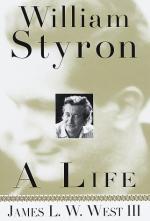|
This section contains 857 words (approx. 3 pages at 300 words per page) |

|
SOURCE: "Among the Whippoorwills," in Times Literary Supplement, December 10, 1993, p. 4732.
Below, Leader concludes that, in writing the stories contained within A Tidewater Morning, Styron sought to achieve personal integrity.
The pivotal moment in each of the three linked stories in William Styron's new book involves a memory of dissolution or release, one accompanied by a sudden rush of strong feeling. These are moments of breakthrough as well as breakdown, though unlike comparable fictional epiphanies (those in John Cheever's stories, for instance) the insights they offer are mostly psychological or social rather than visionary.
The memories in question belong to the narrator, Paul Whitehurst, Styron's thinly disguised fictional alter ego. In the first story, "Love Day", set on board a troopship in the Pacific in 1945, the narrator is twenty, a Marine platoon leader, "incandescent" with health, "golden", "almost fearless". The memory that overtakes the narrator has "a luminous, mnemonic...
|
This section contains 857 words (approx. 3 pages at 300 words per page) |

|


